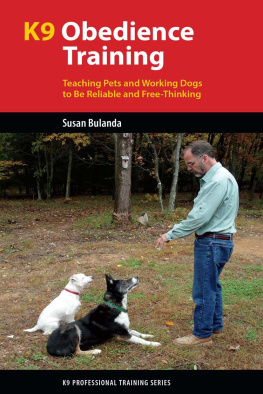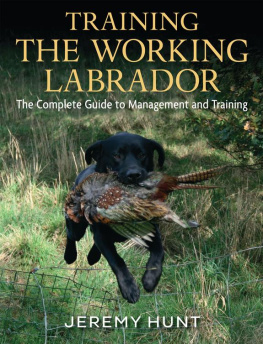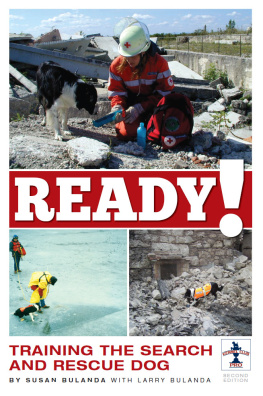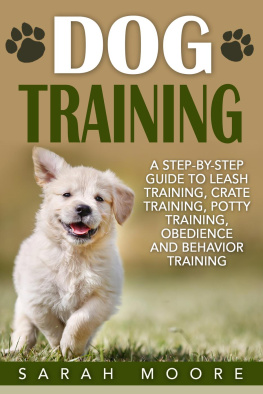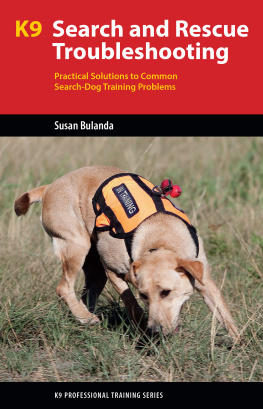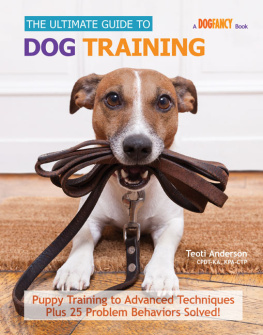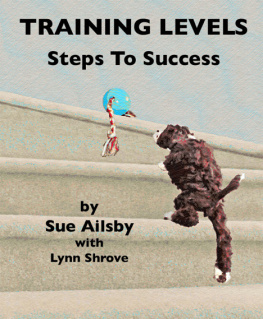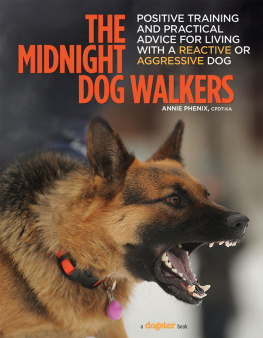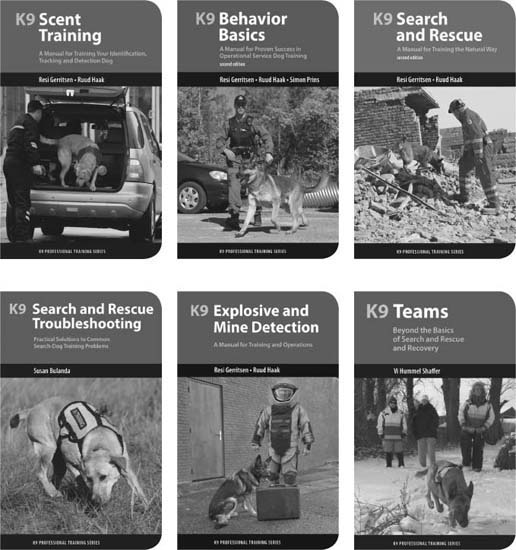Become a better trainer with the K9 Professional Training Series
The K9 Professional Training Series teaches proven, effective, and positive training methods from highly experienced and respected trainers from Europe and North America. These uniquely authoritative manuals combine expert knowledge with detailed graphics and images.
See the complete list at
dogtrainingpress.com
K9 OBEDIENCE TRAINING
Teaching Pets and Working Dogs to Be Reliable and Free-Thinking
Susan Bulanda
K9 Professional Training Series

Copyright 2019 Susan Bulanda
19 20 21 22 23 5 4 3 2 1
Thank you for buying this book and for not copying, scanning, or distributing any part of it without permission. By respecting the spirit as well as the letter of copyright, you support authors and publishers, allowing them to continue to create and distribute the books you value.
Excerpts from this publication may be reproduced under licence from Access Copyright, or with the express written permission of Brush Education Inc., or under licence from a collective management organization in your territory. All rights are otherwise reserved, and no part of this publication may be reproduced, stored in a retrieval system, or transmitted in any form or by any means, electronic, mechanical, photocopying, digital copying, scanning, recording, or otherwise, except as specifically authorized.
Brush Education Inc.
www.brusheducation.ca
contact@brusheducation.ca
Cover design: John Luckhurst; Cover image: Susan Bulanda
Interior design: Carol Dragich, Dragich Design
Printed and manufactured in Canada
Library and Archives Canada Cataloguing in Publication
Title: K9 obedience training : teaching pets and working dogs to be reliable
and free-thinking /Susan Bulanda.
Names: Bulanda, Susan, author.
Description: Series statement: K9 professional training series
Identifiers: Canadiana (print) 20190076836 | Canadiana (ebook) 20190076895 |
ISBN 9781550597912 (softcover) | ISBN 9781550597929 (PDF) |
ISBN 9781550597936 (Kindle) | ISBN 9781550597943 (EPUB)
Subjects: LCSH: DogsTrainingHandbooks, manuals, etc. |
LCSH: Working dogsTrainingHandbooks, manuals, etc. |
LCSH: DogsBehavior. | LCSH: Working dogsBehavior.
Classification: LCC SF431 .B85 2019 | DDC 636.7/0835dc23
Dedication
I want to dedicate this book to my very dear and good friend Dan Guin. He started as an old-fashioned dog trainer and had the wisdom to change to positive training methods. He attended both of my programs at Kutztown University and came with me on most of my consults. His understanding of canine nature and behavior has been a real asset for me. He will be dearly missed.
Dan Guin
19372018
Acknowledgments
I want to thank Tom Lore, Meaghan Craven, Kay Rollans, John Luckhurst, Carol Dragich, and Lauri Seidlitz from Brush Education Inc. for all of their help on this book and on K9 Search and Rescue Troubleshooting, my previous book. They are an excellent team, making the publication of both books an enjoyable experience. I also want to thank Kathy Montgomery for reading the rough draft of this book and for posing for some of the photos. Vi Hummel Shaffer also deserves a thanks for proofreading this manuscript and giving me helpful input. Last but not least, I want to thank Matt and Jade Madairy and their dog Grady, as well as Kevin and Ginger Bronke and their dog Sunny, for being the subjects of many of the photos in this book.
Foreword
Your dog depends on you for his safety and well-being, and the best way to ensure this is through good communication that is grounded in solid obedience training. K9 Obedience Training: Teaching Pets and Working Dogs to Be Reliable and Free-Thinking is aimed at providing the best foundational obedience training for future working dogs and their handlers who will go beyond basic obedience to specialized training. That being said, it is also the best guide for domestic dogs (whether they be puppies or wise, old veterans) and their dog-loving owners, and for anyone considering getting a dog. Sues knowledge, skills, and internationally recognized expertise come from years of training and handling working dogs, including search and rescue (SAR) dogs, sled dogs, and problem dogs (and people). Her philosophy is based on communication and a positive training methodthat is, a method that focuses on positive reinforcement rather than negative, punishment-based communication. What makes K9 Obedience Training special is that it explains what to do, what not to do, and, most importantly, why.
Sue details how to communicate with your dog and lays out the necessary steps for successful obedience training. The book explains, for example, that you must choose specific words for specific commandsand commit to their consistent usebefore trying to teach them to your dog. She further explains teaching tools, offers excellent tips and exercises, and discusses some of the differences between these and other dog training methods. She outlines common mistakes and basic issues that dog trainers, handlers, and owners make, and how to avoid them. Whats more, Sue lets us in on how ours dogs themselves think about and understand training.
It is critical to understand that you have a thinking dogso you ought to be a thinking owner. You must clearly understand the behaviors and skills that you want to train before you teach them to your dog, and you must think about how your dog thinks in order to avoid miscommunication. Human language is a foreign language to a dog. They dont understand it the way we do; rather, for a dog that has learned to recognize a human word, that word will be linked to a very specific action or object, and only to that action or object. Your dog will not understand you if you use synonyms, or if you use a particular word in a new way that the dog has not been trained to understandand this can be frustrating for both you and your dog. Try putting yourself in your dogs position:
O WNER : Bruno!! How many times have I told you to STAY OFF the COUCH!? This is expensive furniture!
B RUNO : Waithow do I STAY and OFF at the same time? Maybe I can OFF my back feet to the floor and STAY my front feet on the Heyyou said STAY OFF the COUCH. Im on the comfy CHAIR. You never said, Chair. By the way, what is furniture?
It is, therefore, very important to learn to think like your dog: work on one command at a time and show your dog the connection between the command word and the desired action. But it is also important to note that, although dogs learn to understand human words in very precise ways, context does matterand we should always remember that although dogs understand our language differently than we do, they are not stupid. Far from it! Dogs are entirely capable of learning different sets of rules for different situations and with different people. They can learn just about anything as long as you can show them clearly what you want, one step at a time.
I dont just write this out of hearsay, but out of experience. I completed Sues Canine Training and Management program at college, and now work as a dog sitter at what I call dog camp. Using Sues method, I have trained the dogs that I watch to respond to rules and commands that may be totally different than those established at their homes. Upon arriving at camp, they race through the house, sniffing everything at nose level to make sure nothing has changed. Then they check the toy basket, make sure the camp cats are around, and jump up on the couch or bed, wriggling around until they are stretched out, belly up (something many are not allowed to do at home, although they may try it once or twice after camp to see if home rules have changed to match camp rules!). At camp, the dogs know that

